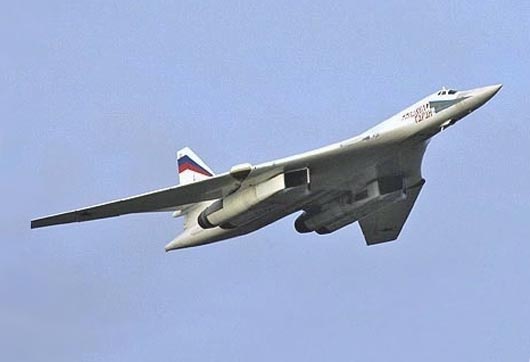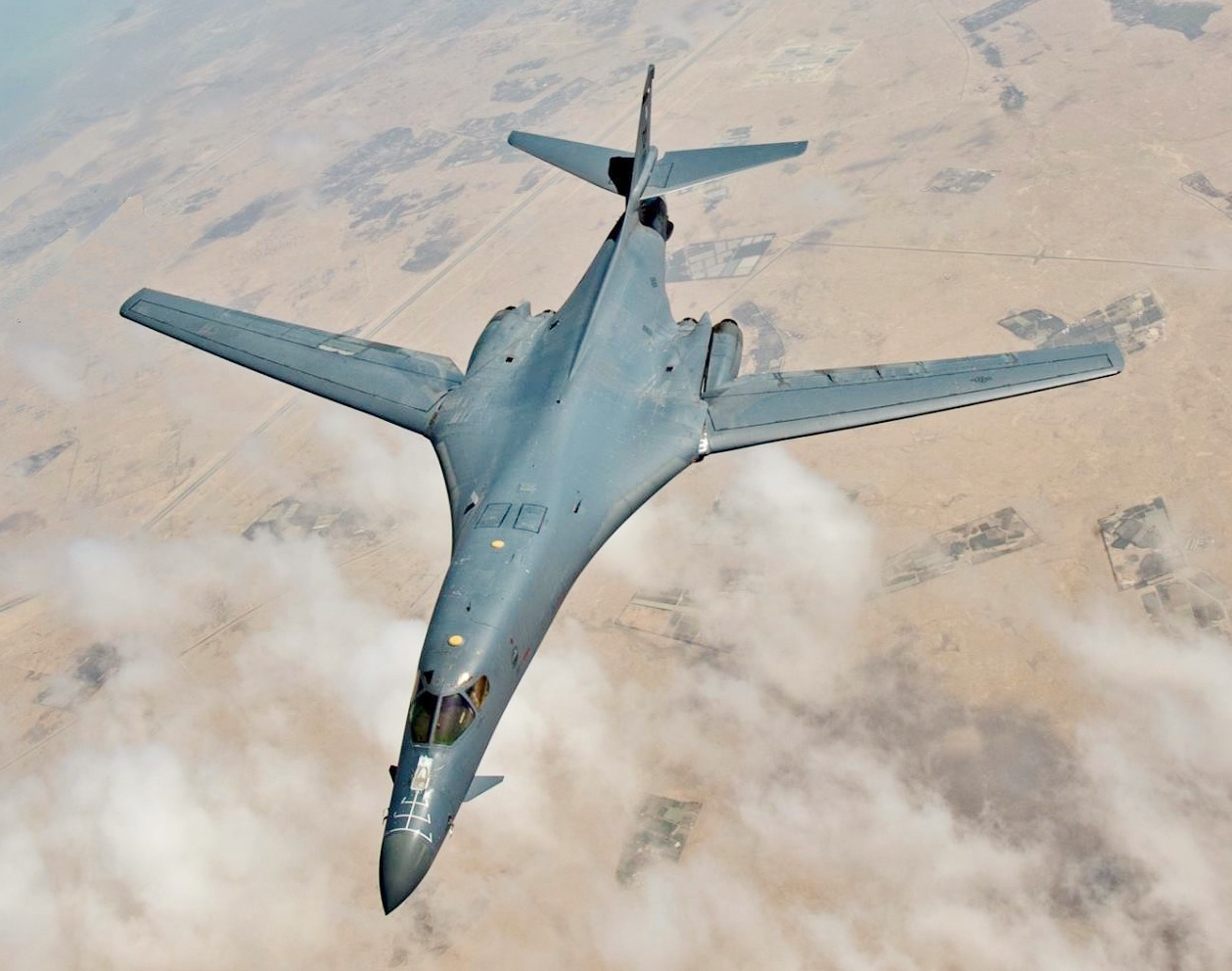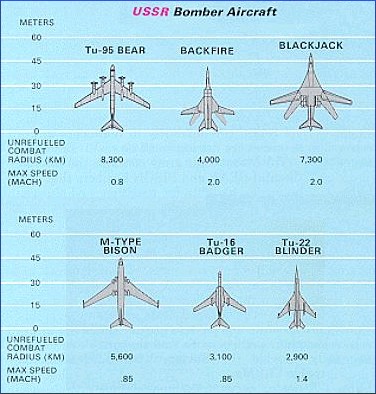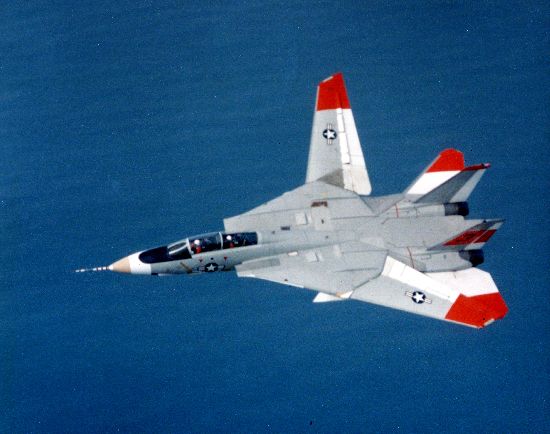|
Tu-160
The Tupolev Tu-160 (russian: Туполев Ту-160 Белый лебедь, translit=Belyj Lebeď, translation=White Swan; NATO reporting name: Blackjack) is a supersonic, variable-sweep wing heavy strategic bomber designed by the Tupolev Design Bureau in the Soviet Union in the 1970s. It is the largest and heaviest Mach 2+ supersonic military aircraft ever built and second to the experimental XB-70 Valkyrie in overall length. As of 2022, it is the largest and heaviest combat aircraft, the fastest bomber in use and the largest and heaviest variable-sweep wing airplane ever flown. Entering service in 1987, the Tu-160 was the last strategic bomber designed for the Soviet Union. As of 2016, the Russian Air Force's Long Range Aviation branch had 16 aircraft in service. The Tu-160 active fleet has been undergoing upgrades to electronics systems since the early 2000s. The Tu-160M modernization program of existing models has begun with the first updated aircraft delivered in December ... [...More Info...] [...Related Items...] OR: [Wikipedia] [Google] [Baidu] |
Kh-55
The Kh-55 (russian: Х-55, also known as RKV-500; NATO reporting name: AS-15 "Kent") is a Soviet/Russian subsonic air-launched cruise missile, designed by MKB Raduga in the 1970s. It has a range of up to and can carry nuclear warheads. Kh-55 is launched exclusively from bomber aircraft and has spawned a number of conventionally armed variants mainly for tactical use, such as the Kh-65SE and Kh-SD, but only the Kh-101 and Kh-555 appear to have been put into service. Contrary to popular belief, the Kh-55 was not the basis of the submarine and ground-launched S-10 Granat or RK-55 ''Relief'' (SS-N-21"Sampson" and SSC-X-4"Slingshot") designed by NPO Novator. The RK-55 is very similar to the air-launched Kh-55 (AS-15 "Kent") but the Kh-55 has a drop-down turbofan engine and was designed by MKB Raduga. Development In the late 1960s, the "Ekho" study conducted by the GosNIIAS institute concluded that it would be more effective to deploy many small, subsonic cruise missiles than ... [...More Info...] [...Related Items...] OR: [Wikipedia] [Google] [Baidu] |
Tupolev PAK DA
The Tupolev PAK DA or PAK DA (russian: ПАК ДА, russian: label=short for, Перспективный авиационный комплекс дальней авиации, Perspektivnyi aviatsionnyi kompleks dal'ney aviatsii, 'Prospective aviation complex for long-range aviation'), codename ''Poslannik'' (russian: Посланник, , Envoy), is a next-generation stealth strategic bomber being developed by Tupolev for the Long-Range Aviation branch of the Russian Aerospace Forces. The PAK DA is set to complement and eventually replace the older Tupolev Tu-95 in Russia's Air Force service. According to the 2020 Izvestia report, three PAK DA prototypes are expected to be ready for preliminary testing by April 2023, with the state tests to begin in February 2026. The aircraft is expected to enter serial production in 2027. Due to the ongoing modernization of Russia's current bomber fleet and massive purchases of upgraded Tu-160M2s, it is believed that the Russian Defence Mini ... [...More Info...] [...Related Items...] OR: [Wikipedia] [Google] [Baidu] |
Strategic Bomber
A strategic bomber is a medium- to long-range Penetrator (aircraft), penetration bomber aircraft designed to drop large amounts of air-to-ground weaponry onto a distant target for the purposes of debilitating the enemy's capacity to wage war. Unlike tactical bombing, tactical bombers, Penetrator (aircraft), penetrators, fighter-bombers, and attack aircraft, which are used in air interdiction operations to attack enemy combatants and military equipment, strategic bombers are designed to fly into enemy territory to destroy strategic targets (e.g., infrastructure, logistics, Military base, military installations, factories, etc.). In addition to strategic bombing, strategic bombers can be used for tactical bombing, tactical missions. There are currently only three countries that operate strategic bombers: the United States, Russia and China. The modern strategic bomber role appeared after Strategic bombing during World War II, strategic bombing was widely employed, and Atomic bombing ... [...More Info...] [...Related Items...] OR: [Wikipedia] [Google] [Baidu] |
Long Range Aviation
Long-Range Aviation ( rus, Авиация Дальнего Действия, r=Aviatsiya dal'nego deystviya, abbr. to AДД, or ADD, and literally ''Aviation of Distant Action'') is a branch of the Russian Aerospace Forces responsible for delivering long-range nuclear or conventional strikes by aircraft rather than missiles. The branch was previously part of the Soviet Air Forces and Russian Air Force tasked with long-range bombardment of strategic targets with nuclear weapons. During the Cold War, it was the counterpart to the Strategic Air Command of the United States Air Force. Origins, 1936-1940 The first three Air Armies, designated Air Armies of Specific Purpose (or Particular Purpose) were created between 1936 and 1938. In accordance with the predominant Deep operations doctrine, the Red Army was reorganized into six echelons, of which the long-range aviation was the 1st echelon. The 2nd echelon consisted of: heavy tanks; the 3rd echelon: medium and light tanks; the ... [...More Info...] [...Related Items...] OR: [Wikipedia] [Google] [Baidu] |
Variable-sweep Wing
A variable-sweep wing, colloquially known as a "swing wing", is an airplane wing, or set of wings, that may be swept back and then returned to its original straight position during flight. It allows the aircraft's shape to be modified in flight, and is therefore an example of a variable-geometry aircraft. A straight wing is most efficient for low-speed flight, but for an aircraft designed for transonic or supersonic flight it is essential that the wing be swept. Most aircraft that travel at those speeds usually have wings (either swept wing or delta wing) with a fixed sweep angle. These are simple and efficient wing designs for high speed flight, but there are performance tradeoffs. One is that the stalling speed is increased, necessitating long runways (unless complex high-lift wing devices are built in). Another is that the aircraft's fuel consumption during subsonic cruise is higher than that of an unswept wing. These tradeoffs are particularly acute for naval carrier-b ... [...More Info...] [...Related Items...] OR: [Wikipedia] [Google] [Baidu] |
Swing-wing
A variable-sweep wing, colloquially known as a "swing wing", is an airplane wing, or set of wings, that may be swept back and then returned to its original straight position during flight. It allows the aircraft's shape to be modified in flight, and is therefore an example of a variable-geometry aircraft. A straight wing is most efficient for low-speed flight, but for an aircraft designed for transonic or supersonic flight it is essential that the wing be swept. Most aircraft that travel at those speeds usually have wings (either swept wing or delta wing) with a fixed sweep angle. These are simple and efficient wing designs for high speed flight, but there are performance tradeoffs. One is that the stalling speed is increased, necessitating long runways (unless complex high-lift wing devices are built in). Another is that the aircraft's fuel consumption during subsonic cruise is higher than that of an unswept wing. These tradeoffs are particularly acute for naval carrier-bas ... [...More Info...] [...Related Items...] OR: [Wikipedia] [Google] [Baidu] |
Russian Air Force
"Air March" , mascot = , anniversaries = 12 August , equipment = , equipment_label = , battles = , decorations = , battle_honours = , battle_honours_label = , flying_hours = , website = , commander1 = President Vladimir Putin , commander1_label = Supreme Commander-in-Chief of the Russian Defence Forces , commander2 = Army General Sergei Surovikin , commander2_label = Commander-in-Chief of the Aerospace Forces , commander3 = Lieutenant general , commander3_label = Commander-in-Chief of the Russian Air Force , notable_commanders = , identification_symbol = , identification_symbol_label = Flag , identification_symbol_2 = , identification_symbol_4 ... [...More Info...] [...Related Items...] OR: [Wikipedia] [Google] [Baidu] |
Kazan Aircraft Production Association
Kazan Aircraft Production Association (KAPO; russian: Казанское авиационное производственное объединение имени С. П. Горбунова, Kazanskoye Aviatsionnoe Proizvodstvennoe Obyedinenie imeni S.P. Gorbunova) is an aircraft manufacturer based in Kazan, Russia. It has built more than 18,000 aircraft of 34 types during its history.Kazan Aircraft Production Association named for S P Gorbunov Jane's All the World's Aircraft History The company traces its origins to the Fili plant of the Russo-Balt corporation, which was established ...[...More Info...] [...Related Items...] OR: [Wikipedia] [Google] [Baidu] |
Ukrainian Air Force
The Ukrainian Air Force ( uk, Пові́тряні си́ли Збро́йних сил Украї́ни) is the air force of Ukraine and one of the five branches of the Armed Forces of Ukraine. Its headquarters are in the city of Vinnytsia. When the Soviet Union dissolved in 1991, many aircraft were left in Ukrainian territory. Ever since, the Ukrainian Air Force has been downsizing and upgrading its forces. The main inventory of the air force still consists of Soviet-made aircraft. As of 2007, 36,300 personnel and 225 aircraft were in service in the Ukrainian Air Force and Air Defense forces. Since Ukrainian independence in 1991, the air force has suffered from chronic underinvestment, leading to the bulk of its inventory becoming mothballed or otherwise inoperable. Despite this, Ukraine still possesses the world's 27th largest air force and the seventh largest air force in Europe, largely due to the ability of its domestic defense industry Ukroboronprom and its Antonov subs ... [...More Info...] [...Related Items...] OR: [Wikipedia] [Google] [Baidu] |
Heavy Bomber
Heavy bombers are bomber aircraft capable of delivering the largest payload of air-to-ground weaponry (usually bombs) and longest range ( takeoff to landing) of their era. Archetypal heavy bombers have therefore usually been among the largest and most powerful military aircraft at any point in time. In the second half of the 20th century, heavy bombers were largely superseded by strategic bombers, which were often smaller in size, but had much longer ranges and were capable of delivering nuclear bombs. Because of advances in aircraft design and engineering — especially in powerplants and aerodynamics — the size of payloads carried by heavy bombers has increased at rates greater than increases in the size of their airframes. The largest bombers of World War I, the four engine aircraft built by the Sikorsky company in the Soviet Union, could carry a payload of up to of bombs. By the middle of World War II even a single-engine fighter-bomber could carry a bomb loa ... [...More Info...] [...Related Items...] OR: [Wikipedia] [Google] [Baidu] |
Tupolev
Tupolev (russian: Ту́полев, ), officially Joint Stock Company Tupolev, is a Russian aerospace and defence company headquartered in Basmanny District, Moscow. Tupolev is successor to the Soviet Tupolev Design Bureau ( OKB-156, design office prefix ''Tu'') founded in 1922 by aerospace pioneer and engineer Andrei Tupolev, who led the company for 50 years until his death in 1972. Tupolev has designed over 100 models of civilian and military aircraft and produced more than 18,000 aircraft for Russia, the Soviet Union and the Eastern Bloc since its founding, and celebrated its 90th anniversary on 22 October 2012. Tupolev is involved in numerous aerospace and defence sectors including development, manufacturing, and overhaul for both civil and military aerospace products such as aircraft and weapons systems, and also missile and naval aviation technologies. In 2006, Tupolev became a division of the United Aircraft Corporation in a merger with Mikoyan, Ilyushin, Irkut, Su ... [...More Info...] [...Related Items...] OR: [Wikipedia] [Google] [Baidu] |
Heavy Bomber
Heavy bombers are bomber aircraft capable of delivering the largest payload of air-to-ground weaponry (usually bombs) and longest range ( takeoff to landing) of their era. Archetypal heavy bombers have therefore usually been among the largest and most powerful military aircraft at any point in time. In the second half of the 20th century, heavy bombers were largely superseded by strategic bombers, which were often smaller in size, but had much longer ranges and were capable of delivering nuclear bombs. Because of advances in aircraft design and engineering — especially in powerplants and aerodynamics — the size of payloads carried by heavy bombers has increased at rates greater than increases in the size of their airframes. The largest bombers of World War I, the four engine aircraft built by the Sikorsky company in the Soviet Union, could carry a payload of up to of bombs. By the middle of World War II even a single-engine fighter-bomber could carry a bomb loa ... [...More Info...] [...Related Items...] OR: [Wikipedia] [Google] [Baidu] |









